We all know how Apple’s devices have a different charger - they’re called lightning cables. The top-quality cables by Apple provide the devices with quick charging and make sure they don’t damage the port internally. This is essentially why it’s important for you to make sure whether the cable you’re using - or intending to purchase - is genuine, that is, MFi Certified.
This post focuses on unveils the issues with using fake lightning cables that cause charging issues for your Apple devices and how to check whether your cable is MFi Certified.
Issues with a Fake Lightning Cable
If you use a counterfeit or uncertified Lightning cable, you could see these issues:
- An unofficial lightning cable is highly unreliable and is more prone to become problematic for your ultra-expensive iOS devices.
- When you plug in a fake cable, the connector end might fall off, get very hot, or might not fit properly into your device.
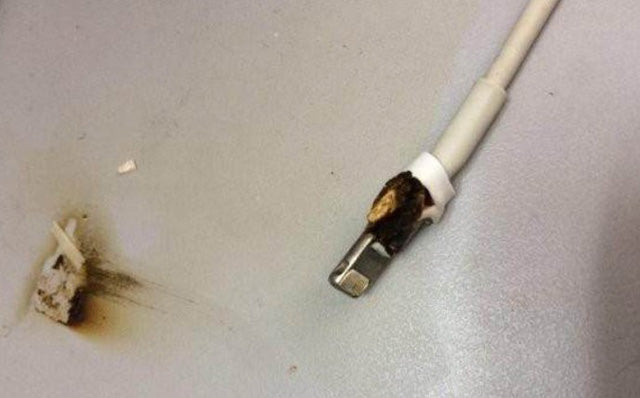
- If the cable you're using is not certified, it won't work in favor of reliability for your Apple product's entire life span. The cable might get ripped and easily damaged.
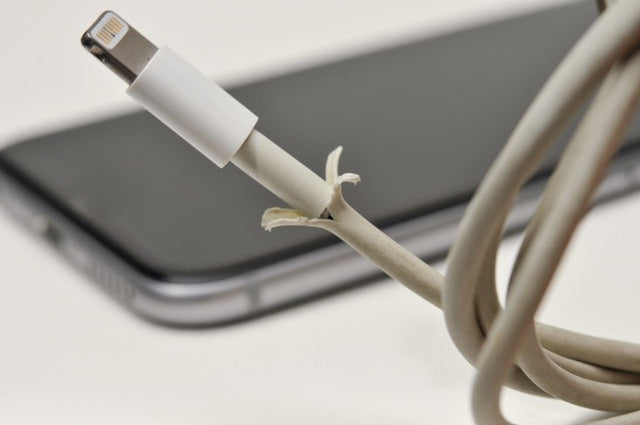
-
You'll get the message “This Accessory May Not Be Supported” right away if the lightning cable you are using doesn't support your jack. You will unable to sync or charge your device.
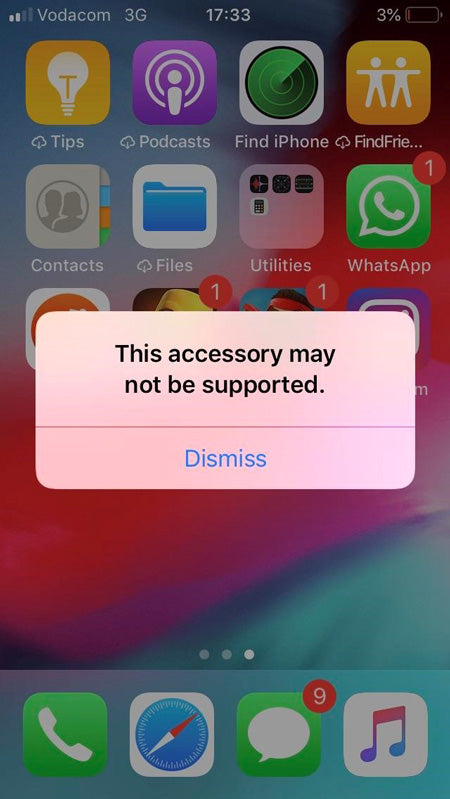
What is MFi Certified?
MFi stands for Made for iPhone/iPad/iPod. As you know, all sorts of Apple products such as iPhone, Mac, or iPad are expensive. That means they shouldn't be taken for granted when it comes to altering the cable, or anything for that matter.

You've probably come across a lightning cable if you are an Apple user; you might have seen many MFi Certified products. If you have no real idea what MFi Certified means, you've come to the right place.
One significant distinction between Apple and Android devices is the cables used for charging. You solely cannot use another cable or uncertified cable for your iPhone; why? Because its overall structure varies. Besides, it ensures durability, headphone jack controls, as well as accessory compatibility.
Apple lightning connectors come with four chips, each serving a different purpose. While one of the chips acts as a security barrier to prevent the reproduction of counterfeit cables, two chips are there to act as transistors while the fourth one’s purpose is still unknown.
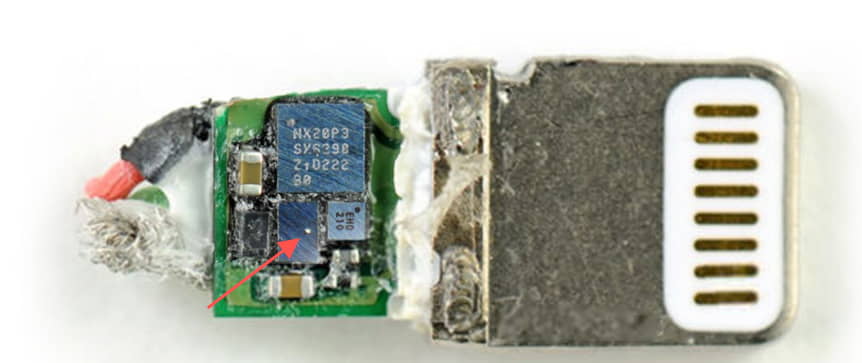
One of the transistor chips is identified as TI BQ2025. It comes with around 5000 logic elements and is built with 128 bits of storage. Additionally, it comes with driver transistors, capacitors, and analog circuits.
Moreover, the chips come with a CRC generation. This monitors data transfer - it checks for redundancies, corruption of files and makes sure there’s no leaking of information to third parties in any way.

4 Ways to Check Whether a Lightning Cable is MFi Certified
Method 1: Check on MFi public database
One of the easiest ways of ensuring whether your cable is MFi Certified is to check Apple’s very own public database of all the products and brands authorized to sell MFi certified accessories.
On this MFi public database, you can enter the brand’s name or the product’s Universal Product Code (UPC). Every brand or product that Apple itself has endorsed to be MFi certified is included in this database. For example, Syncwire is a new brand producing some exceptional quality cables for iPhones. If you search for Syncwire, Apple will list all the accessories with their model numbers that are MFi certified.
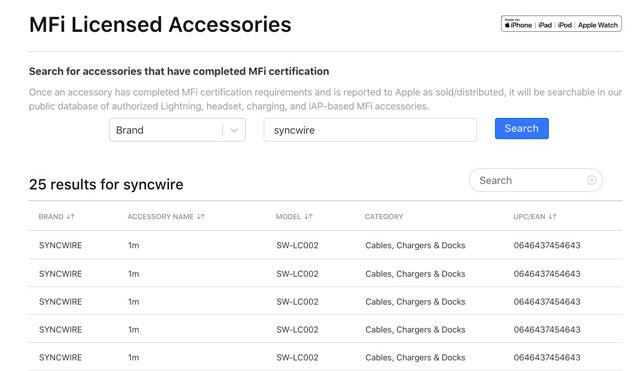
Consequently, if you’ve found a great sale online with prices of iPhone chargers at low prices, make sure to enter the brand’s name on the above-mentioned link. If the product is listed on Apple’s official database, you’re good to go. Otherwise, we recommend you stay away.
Method 2: Check with Lightning Cable Tester
Another way of testing your cable's authenticity is by using the Lightning Cable Tester.
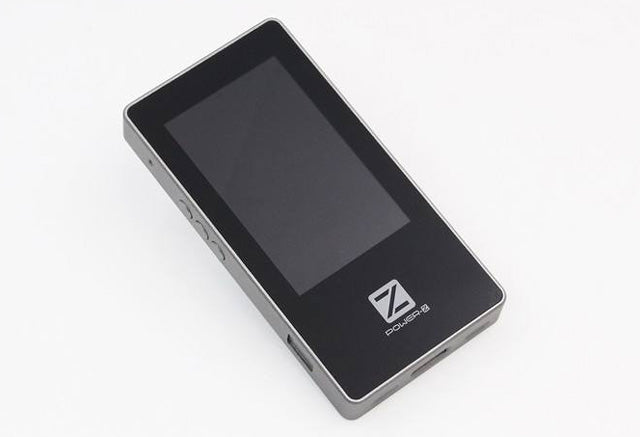
It is more of a professional way to test if the cable you're using for charging your iPhone is apple MFi certified or not.
All you need to do is plug in the Lightning tester and attach your cable with it. Make the other end remain disconnected and the tester will show you a number that calculates the minimum voltage drop at which your USB cable supply is responding.

If you observe that your USB supply voltages are dropping as low as <4.94V, it is time to change the cable; the one you're using is counterfeit. Furthermore, the Lightning Cable Test tells the results in the form of 100 points, which indicates Cable date, Red symbol E, Chip's authenticity (ASIC, NX, ORG), Chip's alterations (PMU, VP, CP, ORG), and Chip's Serial Number.
How is the score of 100 points calculated?
The score is deducted from a total of 100 whenever anything is altered from the original piece. For example, whenever a Taiwanese version alters a certified original ASIC chip, two points are deducted from the score. Similarly, other alterations can deduct several points and this results in a score below 100.
We also test another brand’s Lightning cable, which shows only 90 points:

Neither the certified chip nor the switch chip is the original manufacturer.
Method 3: Check the label on the packaging
Another way Apple recommends is by checking the labels on the packaging of the cables. If the cable is, in fact, genuine, you’ll be able to see an MFi badge somewhere on the box. Moreover, you can also check the cable itself; you should see a label that reads “Designed by Apple in California” and “Assembled in China/Vietnam” about 7 inches from the USB connector. And you'll see a 12-digit serial number at the end of this text.
Method 4: Check the design of the connectors
There are a few detailed changes in the design of the cable as well. For example, the MFi certified USB has a smooth surface with the contacts plated in gold. On the other hand, fake and counterfeit USB has a rougher surface with contacts plated with silver. A more noticeable difference is the size; if the dimensions of your Apple’s charger boot aren’t 7.7mm x 12mm, you’ve got a counterfeit piece there. Also, Apple-branded USB cables are always made of a metallic faceplate insert. On the other hand, fake and counterfeit cables usually come in white or black.
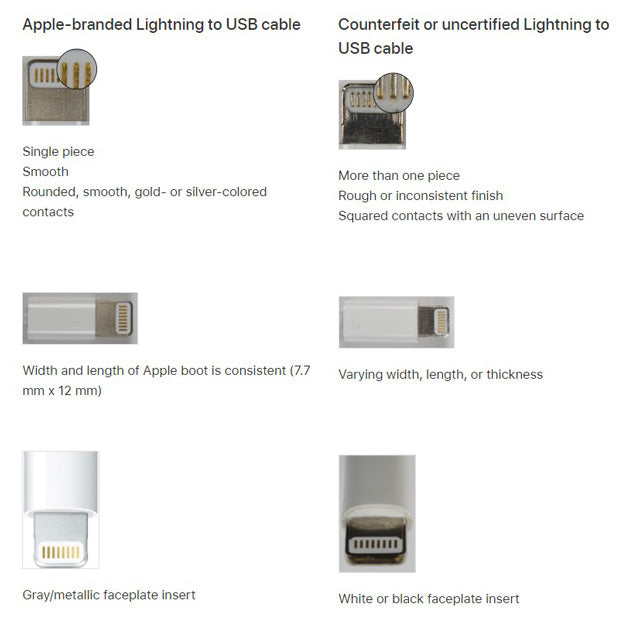
The interlocks of the USB connector are shaped in a trapezoidal form on Apple’s certified lightning cables while the interlocks are more rectangular in shape on fake cables. The two interlocks are also equally spaced from both ends of the USB connector, something you don’t see in counterfeit ones.


Lastly, you’ll find the surface of the USB connector’s insulator to be flat and uniform. For counterfeit cables, the connector will have notches and indents every 2-3 millimeters.
Conclusion
Here we conclude, with the major facts, why you shouldn't opt for counterfeit yet uncertified lightning cables for your Apple products. Make sure it is an Apple MFi Certified cable or don't go for such an option. So-called cables can brutally damage your entire jack and ruin your electronic equipment internally.
There are four methods for confirming if the product is apple MFi Certified: that includes searching on the MFi public database, running a lightning cable detector, checking the label on the packaging, and the connectors and laser etchings on the lighting cable.
Invest in something original rather than going for a seemingly cheaper option; it's going to be a heavy price for you to pay at the end.









Visa
[url=http://www.g5rcw7169063d9q3kv1ccvfdh0k1l115s.org/]utkqyzogmyt[/url]
atkqyzogmyt
tkqyzogmyt http://www.g5rcw7169063d9q3kv1ccvfdh0k1l115s.org/
Der Schnelltest wird hier ausgelassen: Originale Lightning-Stecker sind magnetisch, Nachbauten nicht. ;o)
Visa
[url=http://www.g4tu29hpov86o3i58j6837iwv4v45qf1s.org/]uhwtcmxjqm[/url]
hwtcmxjqm http://www.g4tu29hpov86o3i58j6837iwv4v45qf1s.org/
ahwtcmxjqm